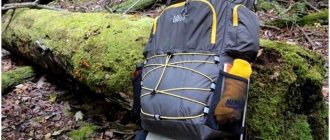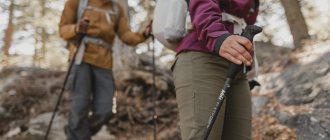If you didn't know, a real travel backpack 5 stabilizing straps. By “real” I don’t mean 30-40 liter models, but real backpacks for hiking from 10 days.
Let's go through the list in descending order of popularity of the back straps. From my experience, the latter raises questions among most tourists, so we will dwell on it in more detail at the end. Let's quickly fly through the first four to refresh your memory.
Belt
Its task is to transfer the weight of the backpack to the hips, which allows you to relieve the shoulders and lower back.
2/3 of the weight carried behind your back should be transferred to your hips through the waist belt, bypassing the spine. The waist belt should wrap around the iliac bones and not slide down, then the likelihood of your back hurting during the hike decreases significantly.
In most models, the length of the waist belt can be shortened, because manufacturers make it with a margin for overweight people.
Some tourists do not use a waist belt. It can be removed so that it does not dangle. To do this, wrap the halves of the belt outward and secure with the latches at the front.
Good to know : What to do if your back hurts while hiking?
Tips for tying straps
We talked about the simplest methods. They are well suited for simple sports backpacks or school bags. If we talk about professional equipment, then the problem of dangling straps can be encountered on the waist belt, chest straps and other parts of the backpack. Before you remove excess length, read some tying tips. After all, comfort during a hike and the health of the spine depend on the length of the shoulder straps.
- Length of shoulder straps. Throw the backpack over your shoulders, having previously filled it with everything you need for the hike, release the straps to their maximum length and begin to pull evenly on the edges until your shoulders take on approximately 1/3 of the total weight.
- Fastening of anti-tilts. This strap is responsible for securing the upper part of the backpack. Its correct location is a few centimeters above the collarbone. It must be kept taut, otherwise the load will be distributed unevenly.
- Chest strap. Here you need to choose the right height and degree of screed. The level of the belts should be at armpit height. Owners of women's backpacks should raise the strap slightly upward so that the straps do not put pressure on the chest.
- Waist belt stabilizers. This element is attached last. It is this that should bear the remaining 2/3 of the load of the total weight. The longus dorsi muscle, which runs along the spinal column, is the strongest. The lumbar region acts as a fixator. The lumbar belt stabilizers do not need to be tightened excessively; moderate tension is sufficient.
If you follow all the steps correctly, then only the shoulder straps and recliners will need periodic adjustments. Therefore, it is these straps of the shoulder system that should be left in a free state. Manufacturers of branded backpacks and professional equipment recommend adjusting the shoulder-belt system before each hike.
Waist Belt Stabilizers
They serve to fix the lower part of the backpack so that it does not dangle while moving in the opposite direction to the tourist.
These straps are useful for backpacks from 60 liters when the load exceeds 18 kg.
Did you know : 10 must-have functions that a hiking backpack should have
Useful tips for tying backpack straps
- To make your hike or trip comfortable, you need to choose quality products. The backpack must be made of durable fabric. Belts must be adjustable, as your health depends on it.
- The adjustment should begin with the lumbar belt and end with the shoulder straps. Before putting the backpack on your shoulders, you should check all the fastenings and straps again. They must be tightly fixed. This is necessary so that when walking the straps do not tear or jump out of the fastening.
Tying the straps on a bag or backpack is easy. The main thing is to know how to do it correctly. The adjustment will take no more than 15 minutes. Don't be afraid to experiment and find convenient options. The product should hang comfortably on the shoulders and distribute the load over several zones to minimize the risk of stretching or injury to the body.
Anti-reclines
– those same mysterious straps, the purpose of which many tourists have no idea about, and certainly don’t know how to regulate.
Anti-folders are responsible for fixing the upper part of the backpack and evenly distributing the load across the shoulders. Like waist belt stabilizers, anti-folders only make sense on large volume backpacks, although some on small models of 20-40 liters, where they are useless.
Remember the three simple rules for adjusting the recoil guards and teach them to others in your group.
How to tie straps on a backpack
Long, dangling straps on a backpack create discomfort and inconvenience for its owner. Aesthetically it also doesn't look very attractive. The simplest everyday question of how to tie the straps on a backpack causes a lot of difficulties. You can often see a picture where a strap that is too long is simply wrapped around the backpack harness and hastily tied into a knot. It's just a solution to a problem, the main thing is that it works. But there are some more creative and aesthetic ways to solve a small problem.
How to tighten, adjust length and angle?
Sometimes backpacks have rings on their adjustment straps. It’s convenient to pull on them and see if the lengths are equal.
1. The attachment point for the anti-recline bars should be located 1-2 cm above the collarbone, then the load on the shoulder strap will be distributed evenly.
The fastenings are on the shoulder straps. To move them, you need to loosen the belt.
If your backpack has anti-folders, but no shoulder mounts, then this is a purely decorative element, like a spoiler on “vases”.
2. The ideal angle between the extended anti-tilt and the horizon is 45 degrees. See pictures below.
3. There should be no gaps between the shoulder strap and your shoulder.
If there are gaps, you need to play with the length of the recliner and the height adjustment of the waist system (this is not the case in shit backpacks).
It is curious that some tourists did not care about the recliners along with the chest straps. Here is a quote from an experienced instructor found on bask.ru:
Manufacturers' advertisements claim that the anti-reclining mechanism works very well, and that its main task is to pull the upper part of the backpack as close to the back as possible. I really want to believe, but the laws of physics say the opposite. The back shaping system, the power frame and the tight packing give the backpack a very rigid shape. It is impossible to change it with anti-recline. And in a well-designed backpack, it’s also unclear why.
You yourself must decide before the hike what is comfortable for you and what is not. The main thing is the pleasure gained from the kilometers traveled.
Now you know everything about anti-kickback.
Honest analysis : Opinion about Quechua travel backpacks: how justified is the price and is it worth buying?
Useful DIYs
I really like my backpack. It has compression straps on the sides which are very useful for securing a tent or sleeping pad. But when I'm not using these straps, they become one hell of a bunch of dangling straps. Of course, I can shorten all the straps, just cut them to the minimum required length. But I sometimes need compression straps to secure things. Some backpacks have small pieces of Velcro at the end of the straps to roll them up and secure them in place.
Shorten a Backpack Straps
But you should always open the Velcro, adjust the length and close them again. I found a solution that is very easy and quick to implement (no sewing required). This is done most easily if your straps are double folded at the end and thus have a small closed channel that you can use.
All you need is a bungee cord, scissors and a lighter. And some very minimal knot tying skills. Cut a small piece of elastic cord. Thread one end through the channel at the end of the backpack strap.
And thread the other end of the cord under the return strap of the backpack. This should be clear when you look at the photographs. If it’s not clear from the photographs, there is an animation at the bottom of the article that shows how it works.
Tie a regular loop knot. Squeezing the knot with your thumb and forefinger and pulling the loose ends with your other hand, try to bring the knot as close to the strap as possible. Ideally, the elastic cord should be slightly under tension. Once you're sure the knot is tight enough, trim off the loose ends and use a lighter to gently burn the ends so they don't fray.
Now comes the simple part. If you want to release the belt, simply grab the loop and pull. To shorten the belt, simply roll it with your fingers until it is short enough. You can see how it works in the animation below.
This life hack can be useful on any type of backpack, such as urban ones, such as Kanken, and especially tourist ones, where there are many more straps.
More interesting DIY videos:
- The most technologically advanced electric mountain bike...
- Homemade knife sharpener
- Wind generator made from a screwdriver
- Homemade greenhouse made from stretch film
- How to refill an inkjet printer cartridge
- Figure eight made of foam rubber and satin ribbons
Subscribe
0 Comment
Intertextual Reviews
View all comments
Life hack: how to seal the ends of the backpack straps so that the buckles don’t fly out
More than once I have come across models whose straps actually flew out of the buckles when carrying a heavy load. Here are two life hacks to prevent this from happening.
If you haven’t gone camping yet, make a 3 cm bend at the tip and stitch along the edge with a needle. This tip will prevent the belt from coming out.
If you are already hiking, then tie a single knot at the tip, as in the picture below.
Arthur Malosiev
For more than 20 years I have been interested in hiking and rafting: Russia, Cyprus, India, Tien Shan. My Instagram | Facebook
How to attach straps to a backpack
To properly tie the straps on a backpack, it must first be filled. It is best to fill it to the maximum. This way you can evenly distribute the load across your entire back. The things inside need to be securely secured with side ties so that they do not dangle throughout the bag.
Instructions for adjusting fasteners
- We start adjusting the straps from the back. First you need to determine the most comfortable level of the shoulder and lumbar belts. They are tailored to each person individually.
Remember ! The lumbar belts are secured to the hip bones.
- Remove the backpack and loosen all ties. This is necessary so that all belts can be fixed equally.
- We take the backpack and place the support at the level of the pelvis. We put one hand through the shoulder strap and quickly throw the bag on our back. We put the second strap on the second shoulder.
- Let's start adjusting the lumbar area. The belt must be fastened and adjusted to fit your figure. The belt should be on the pelvic bones. It should be comfortably fixed on the body so that the weight of the bag rests not only on the shoulders, but also on the lumbar area.
Remember! The belt should not tighten the body or hang.
- Adjusting the shoulder mounts. This is one of the important stages, since it determines how tightly the product will fit to the back. It is best to choose products with soft inserts; they do not rub your shoulders so much and are comfortable to use. Fix the product so that it fits tightly to your back, but does not hinder movement. When adjusting, tighten the straps until you feel an excess of weight back.
- Let's move on to adjusting the chest strap. The belt must be secured so that the person can breathe normally. This belt is responsible for positioning the product on the back.
Additional straps
- Adjustment of additional belt. Almost all hiking backpacks have additional straps. They are located in the collarbone area on the shoulder straps. With their help, it is possible to achieve the correct position of the backpack on the back. They are pulled at a level of 30° to the surface of the earth. If the straps are excessively long, they can be trimmed.
- Product setup must be consistent and clear. If you make a mistake or forget about any straps, the accessory can dangle or, conversely, put a lot of pressure on your arms and neck. Due to the incorrect position of the bag, a person quickly gets tired and his back and arms begin to hurt. In addition, if you put too much pressure on your forearm or shoulder with belts, the bleeding may worsen and your hands will begin to feel very cold.
To tie your belts correctly, you don’t have to buy special tools or measure with a centimeter. It will be enough to just change the location of the backpack a few times and walk around the house with it a little. If you feel comfortable and comfortable, then you did everything right.








